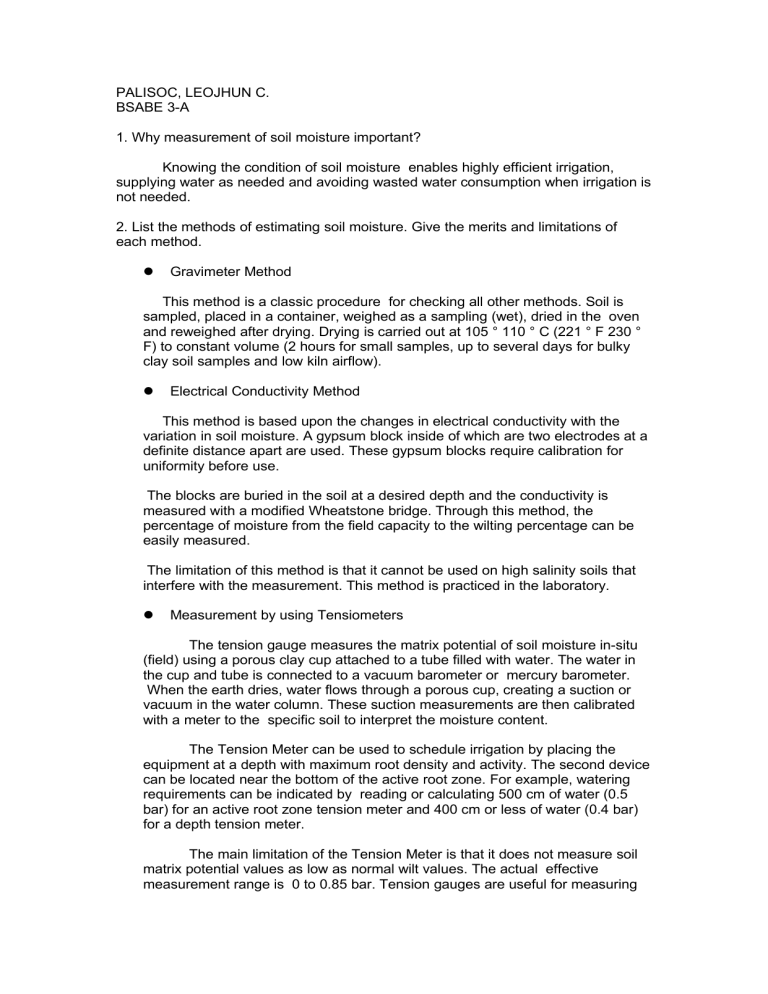
PALISOC, LEOJHUN C. BSABE 3-A 1. Why measurement of soil moisture important? Knowing the condition of soil moisture enables highly efficient irrigation, supplying water as needed and avoiding wasted water consumption when irrigation is not needed. 2. List the methods of estimating soil moisture. Give the merits and limitations of each method. Gravimeter Method This method is a classic procedure for checking all other methods. Soil is sampled, placed in a container, weighed as a sampling (wet), dried in the oven and reweighed after drying. Drying is carried out at 105 ° 110 ° C (221 ° F 230 ° F) to constant volume (2 hours for small samples, up to several days for bulky clay soil samples and low kiln airflow). Electrical Conductivity Method This method is based upon the changes in electrical conductivity with the variation in soil moisture. A gypsum block inside of which are two electrodes at a definite distance apart are used. These gypsum blocks require calibration for uniformity before use. The blocks are buried in the soil at a desired depth and the conductivity is measured with a modified Wheatstone bridge. Through this method, the percentage of moisture from the field capacity to the wilting percentage can be easily measured. The limitation of this method is that it cannot be used on high salinity soils that interfere with the measurement. This method is practiced in the laboratory. Measurement by using Tensiometers The tension gauge measures the matrix potential of soil moisture in-situ (field) using a porous clay cup attached to a tube filled with water. The water in the cup and tube is connected to a vacuum barometer or mercury barometer. When the earth dries, water flows through a porous cup, creating a suction or vacuum in the water column. These suction measurements are then calibrated with a meter to the specific soil to interpret the moisture content. The Tension Meter can be used to schedule irrigation by placing the equipment at a depth with maximum root density and activity. The second device can be located near the bottom of the active root zone. For example, watering requirements can be indicated by reading or calculating 500 cm of water (0.5 bar) for an active root zone tension meter and 400 cm or less of water (0.4 bar) for a depth tension meter. The main limitation of the Tension Meter is that it does not measure soil matrix potential values as low as normal wilt values. The actual effective measurement range is 0 to 0.85 bar. Tension gauges are useful for measuring the moisture content of sandy soils rather than clayey soils due to the high matrix potential present in early soils. Neutron Scattering Method Neutron probes appear like flashlight cylinders with lengthy cords attached.The probe consists of radioactive material (radium or beryllium that emits hastily transferring neutrons). As the neutrons emitted from the probe collide with hydrogen ions (of which water is a chief source), they're slowed and deflected, and a number of the slowed deflected neutrons are deflected lower back to the probe in which a counter measures them. Only slowed neutrons are counted. The extra slowed neutrons that return (indicating massive quantity of collisions), the extra the water content material of the soil. 3. For what purposes would you consider feel and appearance of the soil sufficiently accurate as an indicator of soil moisture content? 4. The volume of the soil wetted to field capacity by an irrigation depends on several factors. List four of these factors Temperature and moisture are the two main factors affecting its development. , especially crop residue and decaying roots, promotes aggregation so that larger soil pores develop, allowing water to infiltrate more readily. Determined by the proportion of different soil separates--sand, silt and loam--in a soil. 5. Discuss some of the common symptoms which indicate that the permanent wilting point have already been reached. Wilting point is the minimum soil moisture required by a plant not to wilt. At this point, any decrease in soil moisture will result in wilting. When a plant wilts, its leaves dry out, droop, and wither. 6. Explain why bulk density and apparent specific gravity have unequal dimensions but have equal numerical values? Specific gravity (SG) and bulk density (BD) are physical tests for an object. Specific gravity is the ratio of the weight of a volume of the substance to the weight of an equal volume of the reference substance. Bulk density is weight of a unit volume of a material to the same volume of water including voids.


